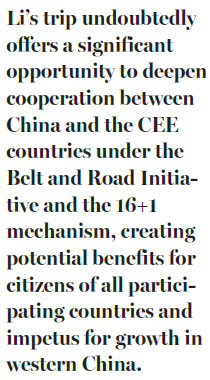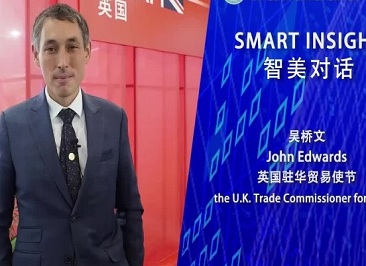16+1 cooperation offers catalyst for growth
Wang Huiyao
Updated:2018-07-04
China Daily Europe
Along with the Belt and Road, it creates potential benefits for citizens of all participating countries and impetus for western China
Premier Li Keqiang's ongoing European visit will make a big difference for Central and Eastern European countries and the region. His trip will see the seventh meeting of the heads of government of China and 16 CEE countries - the so-called 16+1 - as well as the fifth round of China-Germany intergovernmental consultations.
Li's trip undoubtedly offers a significant opportunity to deepen cooperation between China and the CEE countries under the Belt and Road Initiative and the 16+1 mechanism, creating potential benefits for citizens of all participating countries and impetus for growth in western China.

Since its inception in 2012, the 16+1 mechanism has developed and brought progress in many areas. China-CEE trade has increased continuously, growing by 15.9 percent in 2017 to $6.8 billion (5.8 billion euros; £5.2 billion). In the first five months of this year, trade has grown even faster, at 24.2 percent.
Investment by CEE countries in China has now exceeded $1.4 billion, focusing on sectors such as equipment manufacturing, auto parts, chemicals, finance and environmental protection. Chinese companies have invested almost $10 billion in CEE countries, with many more major investment projects in the pipeline.
Growing economic integration is clearly visible in the increasing density of rail connections between China and CEE countries. Just a decade ago, there was no direct rail freight service between China and Europe. Now the cross-border network has bridged 35 Chinese cities and 34 European cities in 12 countries, including direct rail freight services to Poland, the Czech Republic, Bulgaria and Serbia.
Both sides have also established diverse forms of financial cooperation, creating the China-CEE Fund and platforms such as the China-CEEC Inter-Bank Association to expand financing channels for cooperative projects.

The China-CEE leaders' meeting, the first in the second five-year phase of 16+1 cooperation, will focus on the theme of open and pragmatic cooperation and sharing the fruits of development. Building on the progress achieved since 2012, in this new phase we should work to both deepen and broaden cooperation, in particular developing the potential of CEE countries to act as an important hub for trade across the Eurasian region.
The theme of the summit indicates that leaders wish to expand cooperation beyond the traditional sectors of infrastructure, manufacturing and agriculture, to encompass high-tech sectors, tourism, environmental protection and clean energy. It is hoped that countries will also explore new modes of cooperation. For example, China and Bulgaria have been working together to support the development of small and medium-sized enterprises by creating new financing channels.
Beyond the leaders' summit, the 16+1 provides a useful framework for cooperation at all levels, including between local governments and enterprises. More than 50 provinces and regions have joined the 16+1 association of provincial governors, and two 16+1 mayor forums for capital cities have been held. In the second five-year phase, it is hoped that further platforms can be developed to facilitate diverse forms of cooperation at all levels.
The stable development of Sino-European ties will have a mutually reinforcing effect on China's efforts to deepen integration with CEE countries. To this end, the new round of China-Germany intergovernmental consultations, which Premier Li will attend, is of significance beyond relations between Beijing and Berlin. It also represents a chance to strengthen economic integration across all of Eurasia, and in doing so help push back against current trends of deglobalization.
The deepening of ties between China and CEE countries is an integral part of China's overall development plan, in particular efforts to balance regional growth and boost economic activity in western China. Key cities in western China such as Chongqing are actively participating in the 16+1 mechanism and working to improve the conditions for greater connectivity and integration with CEE countries.
Strategically located as a hub for trans-Eurasian trade, Chongqing enjoys direct links to the prosperous Yangtze River Economic Belt, as well as the Southern Corridor to Southeast Asia, which will form a rail and sea link between Europe and Southeast Asia. Chongqing is also the starting point for the Chongqing-Xinjiang-Europe railway, which stretches all the way to Duisburg, Germany, passing through such key railway hubs as Kutno, Poland. This service has slashed shipping times between Chongqing and Europe to 13 to 16 days, saving around 20 days compared with ocean freight.
Infrastructure investment and 16+1 cooperation are increasing trade between Europe and western China, supporting Chongqing's development as a multimodal logistics hub for rail, air, road and river shipping. In turn, this is drawing in further investment in logistics and associated industries, as well as attracting companies seeking to take advantage of reducing shipping times between China and Europe.

Chongqing is also creating platforms to support new modes of trade, such as a China-Europe cross-border e-commerce platform that will connect more than 30 European countries with the Chinese market. It is estimated that 80 percent of goods purchased through this platform will be shipped directly from Europe to Chongqing via rail, boosting cross-border trade and supporting the upgrading of domestic consumption.
Building on the foundation of friendly ties between China and CEE countries, it is hoped that all sides will work together to further develop 16+1 cooperation mechanisms, exploring new areas for fruitful collaboration while also working to build international support for the initiative. Promoting closer economic ties under this framework will not only benefit participating countries, but also act as a catalyst for economic integration across the Eurasian region, helping to counter the current waves of protectionism.
In addition to improving infrastructure links and intergovernmental cooperation, there also is a need for more interaction at the people-to-people level. This includes academic exchanges and the cultivation and circulation of talent between China and CEE countries. Premier Li has indicated this is a future direction for 16+1 cooperation.
Think tanks also have an important role to play in this regard, by providing new platforms for dialogue and exchange of ideas to deepen mutual understanding and ensure that 16+1 cooperation benefits citizens of all countries.
The author is founder and president of Beijing-based independent think tank Center for China and Globalization and a counselor to the State Council. The views do not necessarily reflect those of China Daily.
Video

John Edwards, the UK trade commissioner for China, praised Chongqing over its rise as a burgeoning center in intelligent manufacturing.





